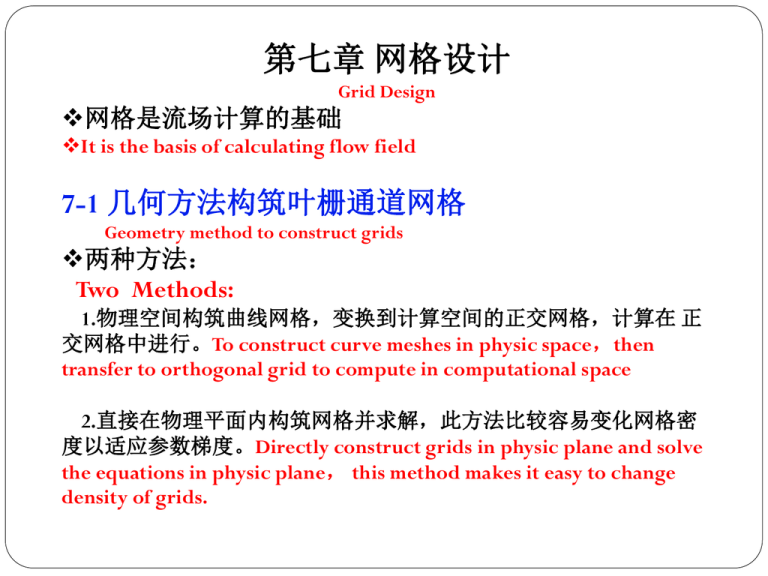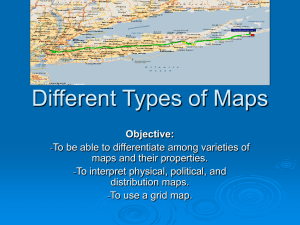平面内的代数网格
advertisement

第七章 网格设计
Grid Design
网格是流场计算的基础
It is the basis of calculating flow field
7-1 几何方法构筑叶栅通道网格
Geometry method to construct grids
两种方法:
Two Methods:
1.物理空间构筑曲线网格,变换到计算空间的正交网格,计算在 正
交网格中进行。To construct curve meshes in physic space,then
transfer to orthogonal grid to compute in computational space
2.直接在物理平面内构筑网格并求解,此方法比较容易变化网格密
度以适应参数梯度。Directly construct grids in physic plane and solve
the equations in physic plane, this method makes it easy to change
density of grids.
网格边界分别平行于求解域边界或与边界相适应。
The grid boundary parallel to the boundary of flow field.
通道内X方向间隔相等 ∆X=const
Keep constant grid gap inside channel
通道进口前
In front of channel
通道出口后
Behind the channel
按指数规律伸展∆X
∆X changes in power law
Y方向网格间距常数(Euler方程计算)
The grid gaps in Y direction kept constant
几何关系如下
x
Geometry relationship
e
( x 0)
( x) 1 x (0 x 1)
3 e(1 x )
( x 1)
y ys
( y)
y p ys
变换后的方程 Transferred equation
U Fx G y 0
Fx F x F x
Gx G x G x
x ex
where
( x 0)
x 1 (0 x 1)
x e (1 x ) 3
( x 1)
a( )
变换关系导数Transform derivatives
x
y p ys
ys
1
[(
y
y
)(
)
(
y
y
)(
)]
p
s
s
2
( y yp )
x
x x
y p
ys
1
[
(
1
)
] e( , )
2
( y yp )
x
x
y 0, y
1
d ( )
y p ys
变换后在
, 平面内的控制方程为
The equation in transformed plane
Ut aF eF dG 0
二.局部加密的叶栅通道网格
The mesh in cascade tunnel with local refining
翼型或叶栅头部附近加密
Refining at leading edge of airfoil and cascade
叶栅通道出现激波时,在激波位置加密
Refining when shock appears in cascade channel
壁面附近边界层
Refining in boundary layer of the wall
例:example
通道内X方向均匀
Uniform grids in X direction of cascade tunnel
x 1 / 60 ~ 1 / 50
通道前与第一个网格宽度 X 1 X ,其余采用
Keep the width of first mesh as same as that of in channel mesh on
others grids
i 1
xi x1
i=2,3,4,I
I 1
下游类似
The same way used for down-stream meshes
Y方向网格划分Grids in y direction
y j hF x
e
j 1
k
J 1
1
ek 1
即y方向按指数规律变化 j 1为ACG边(下)
j 为上边界
J
That is power law used in y direction
一般要求第一个间隔<0.015,可调节J数来保证
The first grid gap is 0.015,it can be ensure by adjusting the total
number of grid J
在计算平面内 , ,各个相邻网格点的间距
in computational plane ,the grid gap is used equal
1
§7-2 几何方法构造c形网格
Construction of C-Type mesh using geometric method
对外流问题(如NACA-0012翼型绕流)通常可构筑C形网格
y
For out flow question
, usually construct c type grids
L
x
将前缘至后缘流向划分50个点,按2次曲线(抛物线分布)
Discrete chord wise into 50 points , using 2nd parabolic curve
i 1 2
xi x L (
)
50
将坐标向左平移0.00125,则NACA-0012的翼向y坐标
Moving coordinates 0.00125 in –direction, then the y coordinates can be
determined by
yi 0.6 0.1015 xi 0.00125 0.2843
xi 0.00125 0.3576( xi 0.00125)
0.126( xi 0.00125) 0.2969 xi 0.00125
i 1,2,51
用两组抛物线构筑c型网格
Construct the mesh using two serial of parabolic curves
§7-3 保角变化法
Conformal transformation
一、基本概念 basic concept
(一)在(x,y)平面内两族网线若存在
on (x,y) plane, the serial carves as follows
( x, y ) cost
( x, y ) cost
x y
y x
则两族网正交
then the two curves are orthorgal
(二):用复数代表(x,y)平面
Define the (x,y) plane with a complex variety
z x iy
两族曲线用复函数表示为
two curves can be denotes with a complex function
w( z ) x, y i ( x, y)
(三)正交坐标系 , 称为
The orthogonality coordinate expressed as
i
两平面的关系 the relationship between two coordinates can
be expressed as
z f
W f ( ) , i ,
在
平面内两线族 in plane the curves are
( , ) const.
( , ) const.
彼此关系可写成
The relationship between physical plane and computational
plane is follows
x iy f f1 , if 2 ,
x f1 ,
y f 2 ,
在z平面和 平面内,点与点相互对应 in physic plane z and
computational plane the points responds each other
x, y i x, y wz w , i ,
两平面内的正交曲线相互对应 the orthorgal curves in two planes
are corresponding
x, y ,
x, y ,
相应的交点也相互对应 the intersect points are corresponding
二:保角变换方法生成网格
Grid generation with conformal transformation (isogonality)
一、例一:复平面内正交直线族
Ex1, the orthogonality curves in complex domain
代表与坐标轴平行的正交网格的两个函数
Two function denote the grids parallel with coordinates
x, y x
x, y y
wz x, y i x, y x iy z
另一复平面
,两平面之间的关系
z
2
In complex domain , the relationship between two domains are
( x iy) ( i )2
x 2 2
y 2
两平面间的网格族是
The grids in two domains are
x c1
双曲线 c
Hyperbolic curves
y 2 c2
双曲线 c /
Hyperbolic curves
2
2
2
1
2
c1 , c2取0,0.1,0.2,0.3……,1.0时对应的网格
Where c1 , cis
2 specified as 0,0.1,0.2,0.3……,1.0,the grids are
(二)例二:复平面内正交线族的函数
Ex2, orthogoral curves in complex plane
( x, y) x, ( x, y) y
W ( ) ( x, y) i( x, y) x iy z
变换关系:
Transformation relationship
z
a2
a2
x (1 2 2 )
2
a
y (1
)
2
2
W ( z ) x iy
W ( z ) W (
a2
) ( , ) ( , )
a2
a2
(1 2
) i (1 2
)
2
2
网格线族为
The grids are
a2
x (1 2
) c1
2
a2
y (1 2
) c2
2
c1 , c2 取0,0.1,0.2,0.3……,1.0时对应的网格线如下图
When c1 , c2 are given as 0,0.1,0.2,0.3… the grids in (x,y) and plane is follow
c1 , c2
利用保角变换可以生成任意封闭曲体外部的网格
The grids around an arbitrary close body
通常用于变换的方程可以写成
The relation used for conformal transformation can be written as
z
c1
c2
2
c3
3
…
7-4 生成网格的微分方程
The partial differential equation method for mesh generation
适/贴体网格生成可以用一个微分方程边值问题实现
Body fitted grids can be gained using the solution of a partial difference EQ
TTM方法(Thompson, Thames and Martin)方法:
利用求解微分方程方法生成空间区域网格的方法
TTM method is the method to generate grids using PDE
要求 requirements
边界形状已知,可以正确描述
Boundary as known, can be described, correct
网格密度可调,有伸展性(可变网格密度)
the density of grids can be adjusted and extended
附面层:尺度为
~
Re
Boundary layer :size
分离流:尺度为弦长C
Separated flow :size C
尾迹区:尺度为 ,弦长C
Wake flow :size C
无粘区(势流):尺度为
Inviscous flow:size
正交性:可以减少差分方程所依赖的网格点数
Orthorgality :may decrease dependent grid of FDE
保形性:物理平面与计算平面方程相同
Conformality: the EQ in physic plane and computational pla are same
(一)TTM方法建立物理平面与计算平面的关系
TTM method is used to found the relationship between physic plane and
computational plane
f1 x, y
f 2 x, y
可用微分方程表示上述变换
The transformation can be expressed as follow
xx yy 0
xx yy 0
正确表述外边界
Define the boundary correctly
在计算平面内,为了差分方程简便,一般用等间隔网格
To be convenient for FD,the grids in computational domain is equal gap
在 ( , )平面内构造正交网格,再在 ( x, y )平面内生成
相应的点坐标,即求逆变换方程的解
Normally, construct the orthogonal grids in plane
(first,
, ) and then create
the corresponding points in
transformation
( x, y )
plane, that is to find the inverse
变换关系
x x( , )
y y ( , )
( x, y)
( x, y)
导数关系:
x x x
y y y
x x
1
x x
0 y y
x x
y y
1 y y
0 x x
y y
x
y
x x 1
y x 0
导数关系:
x y / J ,
1
y x
J
1
x y
J
1
y x
J
且有 and then
1
1
xx ( y ) x ( y ) x
J
J
1
3 ( y3 x 2 y y2 x y2 y x
J
x y y 2x y y y x y y )
2
同理可得 yy
yy
can be obtained in the same way
2
最后可得逆变换方程
Finally the inverse transformation equation obtained
( x2 y2 ) x 2( x x y y ) x ( x2 y2 ) x 0
( x y ) y 2( x x y y ) y ( x y ) y 0
2
2
2
2
求解此方程组可得离散表达形式
To solve above equation and obtain transformation relationship in discreted
form
x( , )
y ( , )
在 ( , ) 平面
0,1
0,1
' '
代表 12
和
43
' '
代表 41
和
3' 2'
' '
' ' and
In ( , ) plane, 0,1 denote line 12
4'3'
,
在 ( x, y ) 平面对应点
' '
12
' '
43
' '
41
3' 2'
边界点给出后就可以得到内点上的各点
正交性和保形性(采用Laplace变换)
Orthogonality and confor
由坐标变换关系可知
From coordinate transformation
y J x
x J y
采用Laplace变换,则
Using Laplace transformation, then
y Jx
x J y
x y ,
x y
x2 y2 x2 y2
x x y y 0
反变换为
inverse transformation is
x x 0
y y 0
没有混合导数项,具有保形性和正交性
No mix derivatives existed
采用正交,保形变换后,全速势方程的形式不变
Using orthogonal, conformal transformation , the fully potential equation unchanged.
( x ) x ( y ) y 0
( ) ( ) 0
拉普拉斯和泊松方程的变换关系式
Laplace vs. poisson transformation
拉普拉斯变换
Laplace transformation
Laplace变换是单值变换,
变换前后的点一一对应
The Laplace transformation is a unique value transformation
物理平面是单连域,则计算平面也是
The single connected field physical plane is still a single connected field in
computational plane
例:机翼(翼型)
Wing as an example
极值原理:参变量的极大、极小值必定在边界上
Extremum principle: The maximum and minimum is on boudary
[0, a]
min 0
[0, b]
min 0
max b
[min , max ]
[min ,max ]
max a
(a,b)
b
2
1
0
a
3
4
(二)泊松方程
poisson equation
可以控制网格密度 the grid density can be controlled
u xx p
解为
p 2
u
x c1 x c2
2
The solution is
u
u
u
0
1
P=0均匀
uniform
x
0
x
P=2>0向下加密
densed to lower
surface
0
x
P=-2<0向上加密
densed to up
surface
用于网格生成的poisson方程
Poisson equation using for mesh generation
xx yy P( , )
xx yy Q( , )
反变换方程
The inverse transformation
x 2 x x J 2 [ x D( , ) x Q( , )]
y 2 y y J 2 [ y D( , ) y Q( , )]
x2 y2
x2 y2
x x y y
J x x y y
P(ξ,η)和Q(ξ,η)可以调整网格密度
P(ξ,η)and Q(ξ,η)may adjust the grid density
n
P( , ) ai sgn( i ) exp[ci i ]
i 1
m
bi sgn( j ) exp[d j ( j ) 2 ( j ) 2 ]
i 1
n
Q( , ) ai sgn( i ) exp[ci i ]
i 1
m
bi sgn( j ) exp[d j ( j ) 2 ( j ) 2 ]
i 1
其中 j ,i 表示要求网格向 (i ,点靠拢,
j)
(i , j )
向
靠拢的网格数量
ai是调整量。n,m表示要
, bj
(,
j ,i ) are
ai , adjust
bj
Where j ,i denotes the grids will approach to
parameters. n,m denotes the number grids to be closed to point.
另一种网格加密办法是由Thomas和Middle coff 提出的
Other method for refining grids is gained by Thomas and Middle coff
7-5 代数法和混合法
一、代数法
采用几何剖分方法,利用代数运算生成计算区域网格,无
需求解微分方程。
等比网格: 间距取
Si Si1 i1
等差网格: 间距取
Si Si1 i1 S (i 1)
指数网格:
Yi C0 x n [C0 (i)]n
(n 2, or ,3)
Yi C0e( xi ) C0 [e(i 1) 1]
Yi cos( xi / C )
cos(
i 1 xi
)
N 1 C
(i 1,2,3,4,…N)
(i 1, 2,3)
( xi [0, ])
2
(i 1,2,…N)
二、混合法
先利用方法生成一个方向(平面内的代数网格),再利用
TTM方法生成另一个方向(平面)内的网格,最后将所生成的网
格联接成一个整体网格
对收扩喷管:横截面用TTM方法,而轴向横截面用代数法。
7-6
动网格设计
非定常流中,边界运动的处理方法。(每一时间步需要重
新生成网格)。
考虑计算流场边界和网格边界的运动,采用积分分解式的质
量守恒律。
d
dv (V W S ) dS 0
dt
S
V
:流体流动速度矢
W
:求解域周边界移动速度矢
将求解域划分成J个网格,则空间离散后的方程为
J
d
dv (V WS ) dS 0
dt
j 1 Sij
网格体积变化
d
dv
dt
W
S
dS
S
每个网格来说
d
dt
J
WSi dSi
(dv)
vol
i
j 1
——几何守恒律。描述几何性质,具有积分形式的守恒律表达式。
在物理空间求解时,需联立上述系数方程
以密度场为例
J
dvi t Wsi d s
j 1
J
dvi t (V Wsi ) d s
j 1 si , j
i
(dV ) i
(dV ) j
---平均密度
在计算空间求解(比较方便)
计算空间的网格不随时间变化,可以用积分形
式的守恒方程也可以用微分形式的守恒方程
计算空间的守恒方程是经过变换的方程,如连
方程
Jt ( JV ) 0
坐标系之间的面积体积关系
dxdy Jdd
dxdyd Jddd
三维Jacobian行列式
流体质量
物理空间
x
y
z
J x
x
y
y
z
z
mi ( x, y ) i dxdy ( x, y ) j Jd d
V
计算空间
mi ( , ) i dd
两者之间的关系
( , )i J ( x, y)
V
V
物理空间微分形式的流体动力学方程为
( x, y)t [ ( x, y)V ] 0
计算空间微分形式的动力学方程为
( , )t [ ( , )V ] 0
or
J ( x, y)t [ J ( x, y)V ] 0
每一时间步都要计算Jacobian行列式J的值
( x, y , z , t )
( x, y , z , t )
( x, y , z , t )
t t
计算求解式和边界分别为
Sc ( , , ) 0
(域边界)
Sci ( , , ) 0 (网格边界)
物理域和网格边界分别为
S ( x, y, z, t ) 0
S1 ( x, y, z, t ) 0
边界移动速度
Wsi ( x , y , z t )si
体积变化守恒律
d
dv si d si ( si )dv
dt V
(运动速度) Wsi
ix jy hz
即
d
Jd d d ( si )Jd d d
dt
在计算平面内网格不随时间变化,故
d
dJ
Jd d d d d d
dt
dt
方程左侧空间导数
J ( si ) J [( x ) x ( y ) y ( z ) z ]
J{[( x ) x ( y )x ( z ) z ]
[( y ) y ( y ) y ( y ) y ]
[( z ) z ( z )z ( z ) z ]}
J [ (Wsi ) (Wsi ) (Wsi ) ]
由于 == =0 故
=tt +xx+ yy+zz=0
t Wsi
同理
t Wsi
t Wsi
由三维空间坐标变换量关系式得
( J ) ( J ) ( J ) 0
J [ (Wsi )] [(t ) (t ) ( t ) ]
其中
t J t
t Jt
t J t
积分形式的变换式
dJ
d d d [(t ) (t ) ( t ) ]d d d
dt
V
可写成微分形式
dJ
(t ) (t ) ( t ) 0
dt
在求解三定常流体力学问题时,已知物理空间求解
域的运动规律,即已知
W si x , y , z ix j y k z
n
n
n
求解步骤:
① 从初始时刻,物理域边界点的坐标( x 0 , y 0 , z 0 ) 及移动速度
( x0 , y 0 , z0,用TTM法生成网格
)
②计算坐标变换量及Jacobian
( x 0 , y0 , z0 )
( x 0 , y 0 , z0 )
( x 0 , y0 , z0 )
x 0 , y0 , z0
J 0 x 0 , y 0 , z0
x 0 , y0 , z0
( x 0 , y 0 , z 0 )i , j , k
③计算时间 后的新边界位置
x1 x 0 x 0
y1 y 0 y 0
z1 z 0 z 0
④由回到①重新生成网格,( x1 , y1 , z1 )反复此过程可以求出每一
个时间步对应的网格和变换量
( x ( n ) , y( n ) , z( n ) ), ( x( n ) , y ( n ) , z( n ) ), ( x ( n ) , y( n ) , z( n ) )
n
n
n
,
及
,
,
x
x
x
xn , xn ,
n ,
x
xn , xn ,
n , n
n
,
x t
t ,
tn
⑤得到Jacobian的差分格式
J n n
t
n
t
n
t
J n J n 1 J n
⑥将J及其变换关系代入流体动力学方程离散格式
本章小结
内容
代数网格
保角变换
TTM
动网格
难点
TTM法
动网格
变换后的方程










